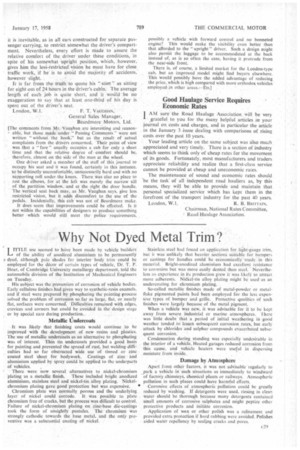Why Not Dyed Metal Trim?
Page 69

If you've noticed an error in this article please click here to report it so we can fix it.
LUTILE. use seemed to have been made by vehicle builders of the ability of anodized aluminium to be permanently. dyed, although pale shades for interior body trim could be employed for the decor of certain types of vehicle, Dr. T. P. Hoar, of Cambridge University metallurgy department, told the automobile division of the Institution of Mechanical Engineers on Tuesday. His subject was the prevention of corrosion of vehicle bodies. Early cellulose finishes had given way to synthetic-resin enamels, and if steel were prepared by phosphating the painting process solved the problem of corrosion so. far as large. flat, or nearly fiat, surfaces were concerned: Difficulties remained with edges, crevices and corners but could be avoided in the design stage or by special care during production.
Metallic Undercoats It was likely that finishing coats would continue to be improved with the development of new resins and plastics. The use of metallic undercoats as an alternative to phosphating was of interest. Thin tin undercoats provided a good basis for painting and prevented the spread of rust, but welding difficulties had so far obstructed wide use of tinned or zinc coated steel sheet for bodywork. Coatings of zinc and aluminium applied by spray could be applied to the underparts of vehicles.
There were now several alternatives to nickel-chromium plating as a metallic finish. These included bright anodized aluminium, stainless steel and nickel-tin alloy plating. Nickelchromium plating gave good protection but was expensive.
Chromium plate was normally porous and the underlying layer of nickel could corrode. It was possible to plate chromium free of cracks, but the process was difficult to control. Failure of nickel-chromium plating on zinc-base die-castings took the form of unsightly pustules. The chromium was strongly cathodic towards the base metal, and the only preventive was a substantial coating of nickel. Stainless steel had found an application for light-gauge trim, hut it was unlikely that heavier sections suitable for bumpers or castings for handles could be economically 'made . in this material. Bright-anodized aluminium had excellent resistance to corrosion but was more easily dented than steel. Nevertheless as experience in its production grew it was likelY to attract more adherents. Nitkel-tin alloy plating might be used as an undercoating. for chromium plating. So-called metallic finishes made of metal-powder or metalflake pigmented paints had been employed for the less. expensive types of bumper and grille. Protective qualities of such
finishes were largely because of the metal pigment. • When a vehicle was new, it was advisable for it to be kept away from severe industrial or marine . atmospheres. There was little doubt that a .period of initial weathering in soad weather tended to. lessen subsequent corrosion rates, but early attack by chlorides and sulphur compounds exacerbated subsequent corrosion.
Condensation during standing was especially undesirable in the interior of a vehicle. Heated garages reduced corrosion from this cause, and vehicle heaters were useful in dispersing moisture from inside.
• Damage by Atmosphere Apart from' otherfactors, it was not advisable regularly to . park a vehicle -in such situations as immediately to windward of factory .chimneys, Chemical plants or railways. Atmospheric pollution in such -places 'could have harmful effects.
Corrosive effects :of atmospheric pollution could be greatly i-educed by Washing. If detergents were used, rinsing in clean water should be thorough because many detergents contained small amounts of corrosive sulphates and might peptize other protective products and initiate corrosion. Application of WitX or other polish was a refinement and provided extra protection if bard rubbing were avoided. Polishes aided water repellency by sealing cracks and pores.
















































































































